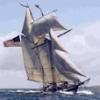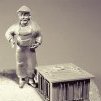-
Posts
603 -
Joined
-
Last visited
Reputation Activity
-
 kruginmi got a reaction from Salty Sea Dog in Bounty Launch by CaptainSteve - FINISHED - Model Shipways - 1:16 Scale - SMALL
kruginmi got a reaction from Salty Sea Dog in Bounty Launch by CaptainSteve - FINISHED - Model Shipways - 1:16 Scale - SMALL
I really like that presentation. Great job!
mark
-
 kruginmi got a reaction from mattsayers148 in Bounty Launch by CaptainSteve - FINISHED - Model Shipways - 1:16 Scale - SMALL
kruginmi got a reaction from mattsayers148 in Bounty Launch by CaptainSteve - FINISHED - Model Shipways - 1:16 Scale - SMALL
I really like that presentation. Great job!
mark
-
 kruginmi got a reaction from CaptainSteve in Bounty Launch by CaptainSteve - FINISHED - Model Shipways - 1:16 Scale - SMALL
kruginmi got a reaction from CaptainSteve in Bounty Launch by CaptainSteve - FINISHED - Model Shipways - 1:16 Scale - SMALL
I really like that presentation. Great job!
mark
-
 kruginmi reacted to CaptainSteve in Bounty Launch by CaptainSteve - FINISHED - Model Shipways - 1:16 Scale - SMALL
kruginmi reacted to CaptainSteve in Bounty Launch by CaptainSteve - FINISHED - Model Shipways - 1:16 Scale - SMALL
Arrr ...
Precious little accomplished (again !!). CaptainSteve was absent from his shipyard this past week, as he had to house-sit for CaptainAndrew. This involved looking after the Captain's dog, cat and wide-screen TV !!
However, the base-stand has now been completed, and thus ...
... one further item he didst ticketh off.
The base-board was trimmed to size, the pedestals fitted, the edging added, and a couple of coats of subdued gloss Tung Oil applied ...
To be honest, Our Hero be mightily chuffed wi' the outcome ...
-
 kruginmi got a reaction from gieb8688 in HMS Druid by kruginmi - 1:48 - cross-section - Hahn
kruginmi got a reaction from gieb8688 in HMS Druid by kruginmi - 1:48 - cross-section - Hahn
Thanks for all the likes and looks.
While the wind howls outside and the temp reads below zero I set my sights on getting the middle stuff (my term) set in the lower hold. This is 3/32" basswood strips primarily on either side of the thickstuff (1/8" basswood). Finally I can call it good.
Next up is the regular planking (1/16" basswood). It shouldn't take too long.
When I started this process of the internal planking I thought the big question was going to be whether to plank up from the keelson or down from the berth deck clamp. The reality was a bunch of jumping around to set the thickstuff and now I am left with the filler. A lot more respect for trying to accurately plank the internal hull of a complete hull, regardless of scale!
Mark
-
 kruginmi got a reaction from fatih79 in HMS Druid by kruginmi - 1:48 - cross-section - Hahn
kruginmi got a reaction from fatih79 in HMS Druid by kruginmi - 1:48 - cross-section - Hahn
Thanks for all the likes and looks.
While the wind howls outside and the temp reads below zero I set my sights on getting the middle stuff (my term) set in the lower hold. This is 3/32" basswood strips primarily on either side of the thickstuff (1/8" basswood). Finally I can call it good.
Next up is the regular planking (1/16" basswood). It shouldn't take too long.
When I started this process of the internal planking I thought the big question was going to be whether to plank up from the keelson or down from the berth deck clamp. The reality was a bunch of jumping around to set the thickstuff and now I am left with the filler. A lot more respect for trying to accurately plank the internal hull of a complete hull, regardless of scale!
Mark
-
 kruginmi got a reaction from gieb8688 in HMS Druid by kruginmi - 1:48 - cross-section - Hahn
kruginmi got a reaction from gieb8688 in HMS Druid by kruginmi - 1:48 - cross-section - Hahn
Another update in the evolution of the Druid-X, this time focusing on the garboard and limber strakes.
For the limber strakes I am still using the thickstuff stock (1/8"). These require a slot to allow the limber boards to fit in between this and the keelson. Using the Byrnes saw I quickly had my raw stock.
Using a spacer piece of wood to insure consistent separation from the keelson I glued in both limber strakes.
Everything ended up looking fit and proper. A good result.
As a companion it was time to put on the first regular planks on the hull (1/16"). The natural choice was the garboard strake - and in fact I did one better, the garboard strake plus one each side. These were again cut rectangular with no specific shaping. The rest of the planking will be custom fit and cut.
The ends of the planks aren't perfectly flush with the aft and fore frames. I am resisting the urge to sand them into all the outside and inside planks are attached to avoid screwing up the face of the frames - as much.
Next up is the middle stuff (my term - hah hah). Some 3/32" stuff that abuts a lot of the thickstuff prior to the regular planking. I also want to get the berth deck clamp in. It wont be too long before the lower hold is sealed in.
Mark
-
 kruginmi got a reaction from fatih79 in HMS Druid by kruginmi - 1:48 - cross-section - Hahn
kruginmi got a reaction from fatih79 in HMS Druid by kruginmi - 1:48 - cross-section - Hahn
Another update in the evolution of the Druid-X, this time focusing on the garboard and limber strakes.
For the limber strakes I am still using the thickstuff stock (1/8"). These require a slot to allow the limber boards to fit in between this and the keelson. Using the Byrnes saw I quickly had my raw stock.
Using a spacer piece of wood to insure consistent separation from the keelson I glued in both limber strakes.
Everything ended up looking fit and proper. A good result.
As a companion it was time to put on the first regular planks on the hull (1/16"). The natural choice was the garboard strake - and in fact I did one better, the garboard strake plus one each side. These were again cut rectangular with no specific shaping. The rest of the planking will be custom fit and cut.
The ends of the planks aren't perfectly flush with the aft and fore frames. I am resisting the urge to sand them into all the outside and inside planks are attached to avoid screwing up the face of the frames - as much.
Next up is the middle stuff (my term - hah hah). Some 3/32" stuff that abuts a lot of the thickstuff prior to the regular planking. I also want to get the berth deck clamp in. It wont be too long before the lower hold is sealed in.
Mark
-
 kruginmi got a reaction from harvey1847 in HMS Druid by kruginmi - 1:48 - cross-section - Hahn
kruginmi got a reaction from harvey1847 in HMS Druid by kruginmi - 1:48 - cross-section - Hahn
Onto the thickstuff. I have learned over and over that reading and studying only take you so far - it is the creation of an accurate 3D model that really brings things to life. And this was reinforced again here.
I had never really associated the thickstuff planks with anything other than longitudinal support. As I once again read over the available material it finally clicked: The thickstuff planks correspond with the futtock joins of the frames. This had escaped me primarily because half of these joins were never visible being on the other side of the frame. It makes perfect sense and brings additional order.
Now I understand the ramifications of how I defined the frame joins at the beginning. At first glance I would say my frames have their opposing joins too close. However, I will invoke my American made cargo ship edict which lets me bypass all normal building standards. I have learned something I did not know before.
The hull is at its widest near the forward part of this cross section and slightly reduced near the aft. I decided not to reflect this change in the thickstuff planks themselves, keeping them straight and rectangular.
The lines penciled on the internal hull represent the berth and gun deck locations. Next up is the limber and garboard strakes.
Stay Building my Friends,
mark
-
 kruginmi got a reaction from Elmer Cornish in HMS Druid by kruginmi - 1:48 - cross-section - Hahn
kruginmi got a reaction from Elmer Cornish in HMS Druid by kruginmi - 1:48 - cross-section - Hahn
Another update in the evolution of the Druid-X, this time focusing on the garboard and limber strakes.
For the limber strakes I am still using the thickstuff stock (1/8"). These require a slot to allow the limber boards to fit in between this and the keelson. Using the Byrnes saw I quickly had my raw stock.
Using a spacer piece of wood to insure consistent separation from the keelson I glued in both limber strakes.
Everything ended up looking fit and proper. A good result.
As a companion it was time to put on the first regular planks on the hull (1/16"). The natural choice was the garboard strake - and in fact I did one better, the garboard strake plus one each side. These were again cut rectangular with no specific shaping. The rest of the planking will be custom fit and cut.
The ends of the planks aren't perfectly flush with the aft and fore frames. I am resisting the urge to sand them into all the outside and inside planks are attached to avoid screwing up the face of the frames - as much.
Next up is the middle stuff (my term - hah hah). Some 3/32" stuff that abuts a lot of the thickstuff prior to the regular planking. I also want to get the berth deck clamp in. It wont be too long before the lower hold is sealed in.
Mark
-
 kruginmi got a reaction from Aussie048 in HMS Druid by kruginmi - 1:48 - cross-section - Hahn
kruginmi got a reaction from Aussie048 in HMS Druid by kruginmi - 1:48 - cross-section - Hahn
Another update in the evolution of the Druid-X, this time focusing on the garboard and limber strakes.
For the limber strakes I am still using the thickstuff stock (1/8"). These require a slot to allow the limber boards to fit in between this and the keelson. Using the Byrnes saw I quickly had my raw stock.
Using a spacer piece of wood to insure consistent separation from the keelson I glued in both limber strakes.
Everything ended up looking fit and proper. A good result.
As a companion it was time to put on the first regular planks on the hull (1/16"). The natural choice was the garboard strake - and in fact I did one better, the garboard strake plus one each side. These were again cut rectangular with no specific shaping. The rest of the planking will be custom fit and cut.
The ends of the planks aren't perfectly flush with the aft and fore frames. I am resisting the urge to sand them into all the outside and inside planks are attached to avoid screwing up the face of the frames - as much.
Next up is the middle stuff (my term - hah hah). Some 3/32" stuff that abuts a lot of the thickstuff prior to the regular planking. I also want to get the berth deck clamp in. It wont be too long before the lower hold is sealed in.
Mark
-
 kruginmi got a reaction from kees de mol in HMS Druid by kruginmi - 1:48 - cross-section - Hahn
kruginmi got a reaction from kees de mol in HMS Druid by kruginmi - 1:48 - cross-section - Hahn
Another update in the evolution of the Druid-X, this time focusing on the garboard and limber strakes.
For the limber strakes I am still using the thickstuff stock (1/8"). These require a slot to allow the limber boards to fit in between this and the keelson. Using the Byrnes saw I quickly had my raw stock.
Using a spacer piece of wood to insure consistent separation from the keelson I glued in both limber strakes.
Everything ended up looking fit and proper. A good result.
As a companion it was time to put on the first regular planks on the hull (1/16"). The natural choice was the garboard strake - and in fact I did one better, the garboard strake plus one each side. These were again cut rectangular with no specific shaping. The rest of the planking will be custom fit and cut.
The ends of the planks aren't perfectly flush with the aft and fore frames. I am resisting the urge to sand them into all the outside and inside planks are attached to avoid screwing up the face of the frames - as much.
Next up is the middle stuff (my term - hah hah). Some 3/32" stuff that abuts a lot of the thickstuff prior to the regular planking. I also want to get the berth deck clamp in. It wont be too long before the lower hold is sealed in.
Mark
-
 kruginmi got a reaction from qwerty2008 in HMS Druid by kruginmi - 1:48 - cross-section - Hahn
kruginmi got a reaction from qwerty2008 in HMS Druid by kruginmi - 1:48 - cross-section - Hahn
Another update in the evolution of the Druid-X, this time focusing on the garboard and limber strakes.
For the limber strakes I am still using the thickstuff stock (1/8"). These require a slot to allow the limber boards to fit in between this and the keelson. Using the Byrnes saw I quickly had my raw stock.
Using a spacer piece of wood to insure consistent separation from the keelson I glued in both limber strakes.
Everything ended up looking fit and proper. A good result.
As a companion it was time to put on the first regular planks on the hull (1/16"). The natural choice was the garboard strake - and in fact I did one better, the garboard strake plus one each side. These were again cut rectangular with no specific shaping. The rest of the planking will be custom fit and cut.
The ends of the planks aren't perfectly flush with the aft and fore frames. I am resisting the urge to sand them into all the outside and inside planks are attached to avoid screwing up the face of the frames - as much.
Next up is the middle stuff (my term - hah hah). Some 3/32" stuff that abuts a lot of the thickstuff prior to the regular planking. I also want to get the berth deck clamp in. It wont be too long before the lower hold is sealed in.
Mark
-
 kruginmi got a reaction from fatih79 in HMS Druid by kruginmi - 1:48 - cross-section - Hahn
kruginmi got a reaction from fatih79 in HMS Druid by kruginmi - 1:48 - cross-section - Hahn
Onto the thickstuff. I have learned over and over that reading and studying only take you so far - it is the creation of an accurate 3D model that really brings things to life. And this was reinforced again here.
I had never really associated the thickstuff planks with anything other than longitudinal support. As I once again read over the available material it finally clicked: The thickstuff planks correspond with the futtock joins of the frames. This had escaped me primarily because half of these joins were never visible being on the other side of the frame. It makes perfect sense and brings additional order.
Now I understand the ramifications of how I defined the frame joins at the beginning. At first glance I would say my frames have their opposing joins too close. However, I will invoke my American made cargo ship edict which lets me bypass all normal building standards. I have learned something I did not know before.
The hull is at its widest near the forward part of this cross section and slightly reduced near the aft. I decided not to reflect this change in the thickstuff planks themselves, keeping them straight and rectangular.
The lines penciled on the internal hull represent the berth and gun deck locations. Next up is the limber and garboard strakes.
Stay Building my Friends,
mark
-
 kruginmi got a reaction from Aussie048 in HMS Druid by kruginmi - 1:48 - cross-section - Hahn
kruginmi got a reaction from Aussie048 in HMS Druid by kruginmi - 1:48 - cross-section - Hahn
Onto the thickstuff. I have learned over and over that reading and studying only take you so far - it is the creation of an accurate 3D model that really brings things to life. And this was reinforced again here.
I had never really associated the thickstuff planks with anything other than longitudinal support. As I once again read over the available material it finally clicked: The thickstuff planks correspond with the futtock joins of the frames. This had escaped me primarily because half of these joins were never visible being on the other side of the frame. It makes perfect sense and brings additional order.
Now I understand the ramifications of how I defined the frame joins at the beginning. At first glance I would say my frames have their opposing joins too close. However, I will invoke my American made cargo ship edict which lets me bypass all normal building standards. I have learned something I did not know before.
The hull is at its widest near the forward part of this cross section and slightly reduced near the aft. I decided not to reflect this change in the thickstuff planks themselves, keeping them straight and rectangular.
The lines penciled on the internal hull represent the berth and gun deck locations. Next up is the limber and garboard strakes.
Stay Building my Friends,
mark
-
 kruginmi got a reaction from dvm27 in HMS Druid by kruginmi - 1:48 - cross-section - Hahn
kruginmi got a reaction from dvm27 in HMS Druid by kruginmi - 1:48 - cross-section - Hahn
Onto the thickstuff. I have learned over and over that reading and studying only take you so far - it is the creation of an accurate 3D model that really brings things to life. And this was reinforced again here.
I had never really associated the thickstuff planks with anything other than longitudinal support. As I once again read over the available material it finally clicked: The thickstuff planks correspond with the futtock joins of the frames. This had escaped me primarily because half of these joins were never visible being on the other side of the frame. It makes perfect sense and brings additional order.
Now I understand the ramifications of how I defined the frame joins at the beginning. At first glance I would say my frames have their opposing joins too close. However, I will invoke my American made cargo ship edict which lets me bypass all normal building standards. I have learned something I did not know before.
The hull is at its widest near the forward part of this cross section and slightly reduced near the aft. I decided not to reflect this change in the thickstuff planks themselves, keeping them straight and rectangular.
The lines penciled on the internal hull represent the berth and gun deck locations. Next up is the limber and garboard strakes.
Stay Building my Friends,
mark
-
 kruginmi got a reaction from qwerty2008 in HMS Druid by kruginmi - 1:48 - cross-section - Hahn
kruginmi got a reaction from qwerty2008 in HMS Druid by kruginmi - 1:48 - cross-section - Hahn
Onto the thickstuff. I have learned over and over that reading and studying only take you so far - it is the creation of an accurate 3D model that really brings things to life. And this was reinforced again here.
I had never really associated the thickstuff planks with anything other than longitudinal support. As I once again read over the available material it finally clicked: The thickstuff planks correspond with the futtock joins of the frames. This had escaped me primarily because half of these joins were never visible being on the other side of the frame. It makes perfect sense and brings additional order.
Now I understand the ramifications of how I defined the frame joins at the beginning. At first glance I would say my frames have their opposing joins too close. However, I will invoke my American made cargo ship edict which lets me bypass all normal building standards. I have learned something I did not know before.
The hull is at its widest near the forward part of this cross section and slightly reduced near the aft. I decided not to reflect this change in the thickstuff planks themselves, keeping them straight and rectangular.
The lines penciled on the internal hull represent the berth and gun deck locations. Next up is the limber and garboard strakes.
Stay Building my Friends,
mark
-
 kruginmi got a reaction from Mike Y in HMS Druid by kruginmi - 1:48 - cross-section - Hahn
kruginmi got a reaction from Mike Y in HMS Druid by kruginmi - 1:48 - cross-section - Hahn
Onto the thickstuff. I have learned over and over that reading and studying only take you so far - it is the creation of an accurate 3D model that really brings things to life. And this was reinforced again here.
I had never really associated the thickstuff planks with anything other than longitudinal support. As I once again read over the available material it finally clicked: The thickstuff planks correspond with the futtock joins of the frames. This had escaped me primarily because half of these joins were never visible being on the other side of the frame. It makes perfect sense and brings additional order.
Now I understand the ramifications of how I defined the frame joins at the beginning. At first glance I would say my frames have their opposing joins too close. However, I will invoke my American made cargo ship edict which lets me bypass all normal building standards. I have learned something I did not know before.
The hull is at its widest near the forward part of this cross section and slightly reduced near the aft. I decided not to reflect this change in the thickstuff planks themselves, keeping them straight and rectangular.
The lines penciled on the internal hull represent the berth and gun deck locations. Next up is the limber and garboard strakes.
Stay Building my Friends,
mark
-
 kruginmi got a reaction from tadheus in HMS Druid by kruginmi - 1:48 - cross-section - Hahn
kruginmi got a reaction from tadheus in HMS Druid by kruginmi - 1:48 - cross-section - Hahn
Onto the thickstuff. I have learned over and over that reading and studying only take you so far - it is the creation of an accurate 3D model that really brings things to life. And this was reinforced again here.
I had never really associated the thickstuff planks with anything other than longitudinal support. As I once again read over the available material it finally clicked: The thickstuff planks correspond with the futtock joins of the frames. This had escaped me primarily because half of these joins were never visible being on the other side of the frame. It makes perfect sense and brings additional order.
Now I understand the ramifications of how I defined the frame joins at the beginning. At first glance I would say my frames have their opposing joins too close. However, I will invoke my American made cargo ship edict which lets me bypass all normal building standards. I have learned something I did not know before.
The hull is at its widest near the forward part of this cross section and slightly reduced near the aft. I decided not to reflect this change in the thickstuff planks themselves, keeping them straight and rectangular.
The lines penciled on the internal hull represent the berth and gun deck locations. Next up is the limber and garboard strakes.
Stay Building my Friends,
mark
-
 kruginmi got a reaction from mtaylor in HMS Druid by kruginmi - 1:48 - cross-section - Hahn
kruginmi got a reaction from mtaylor in HMS Druid by kruginmi - 1:48 - cross-section - Hahn
Onto the thickstuff. I have learned over and over that reading and studying only take you so far - it is the creation of an accurate 3D model that really brings things to life. And this was reinforced again here.
I had never really associated the thickstuff planks with anything other than longitudinal support. As I once again read over the available material it finally clicked: The thickstuff planks correspond with the futtock joins of the frames. This had escaped me primarily because half of these joins were never visible being on the other side of the frame. It makes perfect sense and brings additional order.
Now I understand the ramifications of how I defined the frame joins at the beginning. At first glance I would say my frames have their opposing joins too close. However, I will invoke my American made cargo ship edict which lets me bypass all normal building standards. I have learned something I did not know before.
The hull is at its widest near the forward part of this cross section and slightly reduced near the aft. I decided not to reflect this change in the thickstuff planks themselves, keeping them straight and rectangular.
The lines penciled on the internal hull represent the berth and gun deck locations. Next up is the limber and garboard strakes.
Stay Building my Friends,
mark
-
 kruginmi got a reaction from harvey1847 in HMS Druid by kruginmi - 1:48 - cross-section - Hahn
kruginmi got a reaction from harvey1847 in HMS Druid by kruginmi - 1:48 - cross-section - Hahn
The task for the day was a Keel Rabbet. The difference for me is that this rabbet is more than for looks. I actually need a garboard strake to fit into the rabbet and given the cross section you get to view the results on two ends.
So....off I went. I did drill through the keel, the frames and partway through the keelson at each frame. Four of these holes where then drilled through the false keel. Adding trunnels through the whole assembly made it very stiff.
I am pretty happy with the results. Now I get to start working on stuff that will for the most part be seen!
mark
-
 kruginmi got a reaction from harvey1847 in HMS Druid by kruginmi - 1:48 - cross-section - Hahn
kruginmi got a reaction from harvey1847 in HMS Druid by kruginmi - 1:48 - cross-section - Hahn
It has been some banner time in the workshop the last couple of days. I was boresighted on getting past the frames so this afternoon I was back at it, this time for the internal fairing. To borrow a phrase "Say hello to my little friends"
Cabinet scrapers are very effective in removing wood on the internal hull. Supplement that with some final sanding and you can do a lot without a lot of sawdust flying about. More evidence of my activity is the current state of my rough worktable:
Definitely needs some cleanup tomorrow, but a tidy workshop does not show progress! At the end of the day I can stand back and look at my hull with keel and keelson on (but not yet attached). Still need another hour or so of refinement but I am happy with the progress and I can see the finish for this part of the project:
Tomorrow probably switch to the Lady Anne for awhile.
Stay Building My Friends,
Mark
-
 kruginmi got a reaction from gieb8688 in HMS Druid by kruginmi - 1:48 - cross-section - Hahn
kruginmi got a reaction from gieb8688 in HMS Druid by kruginmi - 1:48 - cross-section - Hahn
Thanks everyone for stopping by.
Tonight was another big night for Druid-X: I affixed the first plank. I am putting the wales on at this time to provide greater longitudinal strength. I traced the wale pattern off of the plans and defined three plank widths. The curvature of the wales was transferred to a piece of 1/8" thick basswood (double the 1/16" plank width) and this pattern cut / sanded out. After I was satisfied with the curve I used dividers to define the width of one plank and also cut and sanded this out. This continued for all three planks.
The middle plank was to span entirely across the cross section, the upper and lower ones being jointed three frames in (different sides). I affixed the middle plank first given it was the easiest one. The following pic shows the top one being put on:
I now laugh looking at this. It was with the click of the shutter that I made a mental note to insure the joint in the lower was made on the opposite side. The opposite side of.the.joint.that.I.had.forgot.to.put.in. The glue sets fast but I was able to pry off the top plank without too much damage, cut the joint and re-attach. Here is a shot of what it was supposed to look like originally:
I added the third plank then sanded the edges flush with the frames.
In this pic you can see the face on view and also the chocks completed on the opposite side of the cross section.
Trying to accomplish a little bit with every hour - Stay Building my Friends,
Mark
-
 kruginmi got a reaction from CharlieZardoz in HMS Druid by kruginmi - 1:48 - cross-section - Hahn
kruginmi got a reaction from CharlieZardoz in HMS Druid by kruginmi - 1:48 - cross-section - Hahn
Slow but steady. I worked the inlays into the front frame using walnut - that should make them pop with the finish. After everything looked good I glued the frame to the jig. I have begun work with the 27th frame (opposite) to do the same. I waited until this time for these pieces so I could accurately account for the bevels. This is targeted for eye candy so I wanted the join pieces to be placed consistently to look their best.
Lots of time spent on the frames. If you have a solid base that is correct, the rest of the build is sooooo much easier. Bummer most of this will not be seen/
The outside of the hull is now faired (the inside is not as is pretty clear). After doing the 27th frame my goal will be to get the wales on for maximum strength and then work the rabbet into the keel prior to attaching that.
Stay Building my Friends,
Mark
-
 kruginmi got a reaction from gieb8688 in HMS Druid by kruginmi - 1:48 - cross-section - Hahn
kruginmi got a reaction from gieb8688 in HMS Druid by kruginmi - 1:48 - cross-section - Hahn
Now to put the bevels in.
First step is to add spacers between the frames where the main wales will be. So....I need to know the height for each frame. I used a light box to copy the plans for the cross section to a blank piece of paper. I then cut the plans so the floor was equivalent to the base jig. This was then glued to a form that allows measurements to be taken off.
.
I then was able to take measurements of the wale upper and lower limits and transfer to the model. Then spacer pieces were added. THEN the sanding starts. I was just focusing on one of the external sides initially. When the full outside is done I will attach the wales for complete stiffness before attempting the inside.
I did find the frames had some 'issues' conforming to a pre-bevel ready install. I had flashbacks to the original Druid when I had problems in the same area. I had though using the top spreaders would solve how this happened but I think there are a couple of issues with the drawn frames on the plans. I actually cut one of the lower legs and re-glued in a slightly different orientation to make things match up better. Some other frames had their slots enlarged to allow more movement prior to gluing. You go slow and check your progress often and it was slowly brought into alignment.
I had a plank at the ready and checked how it laid on the hull often. As a note the first and last frame are still not glued in. I wanted to see exactly how the bevels affected them prior to adding the futtuck join pieces to insure they visually looked right.
For a current look and comparison, the following shot shows a beveled hull on the right and untouched on the left - big difference.
All this work will be hidden (except the keel) and it might thought to be overkill but I wanted this build to be equivalent to the original build.
As an aside, I include a current view of my full HMS Druid at the Lowell Arts Building (pic from them). Not looking too shabby.
Stay Building my Friends,
Mark













